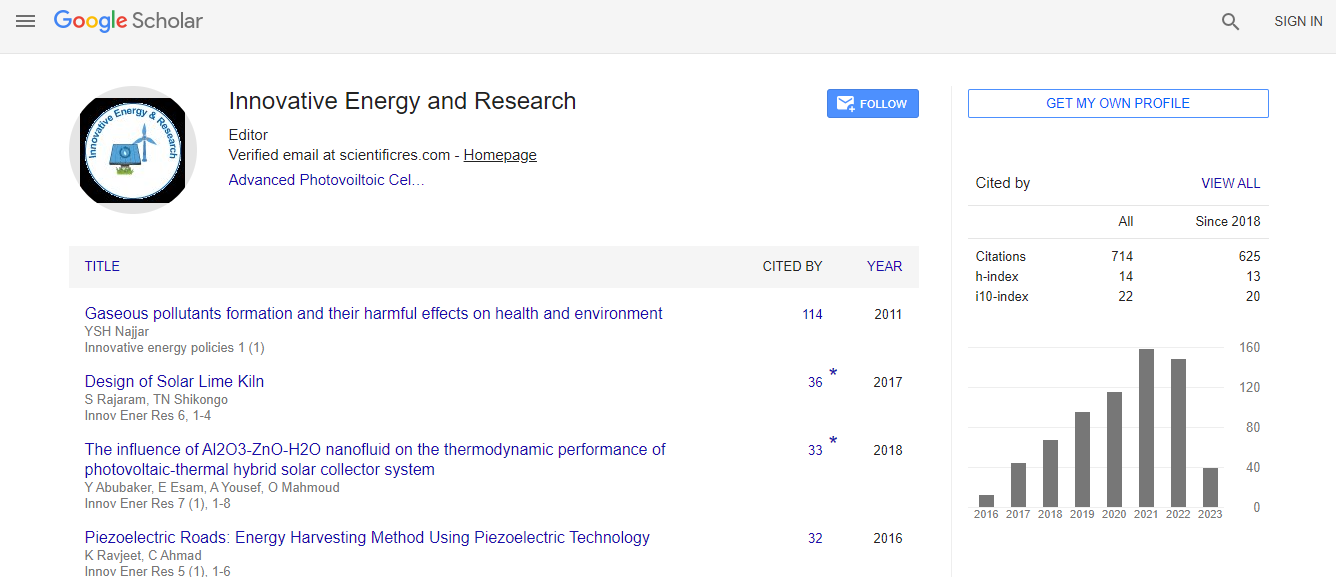Our Group organises 3000+ Global Conferenceseries Events every year across USA, Europe & Asia with support from 1000 more scientific Societies and Publishes 700+ Open Access Journals which contains over 50000 eminent personalities, reputed scientists as editorial board members.
Open Access Journals gaining more Readers and Citations
700 Journals and 15,000,000 Readers Each Journal is getting 25,000+ Readers
Google Scholar citation report
Citations : 712
Innovative Energy & Research received 712 citations as per Google Scholar report
Innovative Energy & Research peer review process verified at publons
Indexed In
- Google Scholar
- Open J Gate
- Genamics JournalSeek
- RefSeek
- Hamdard University
- EBSCO A-Z
- Publons
- Euro Pub
- ICMJE
Useful Links
Recommended Journals
Related Subjects
Share This Page
The role of atomic bond strengths and structural disorder in MXene materials for rechargeable ionbatteries
20th International Conference on Advanced Energy Materials and Research
Wojciech Olszewski, Carlo Marini, Nitya Ramanan, Masashi Okubo, Naurang Lal Saini and Laura Simonelli
ALBA Synchrotron Light Facility, SpainUniversity of Bialystok, PolandThe University of Tokyo, JapanUniversita di Roma La Sapienza, Italy
ScientificTracks Abstracts: Innov Ener Res
Abstract
Ion batteries are a key technology and play a dominant role in today's world. Extensive research efforts have been dedicated to exploring and developing new cathode materials with higher capacities and lifetimes. Recently, a new family of transition metal carbides and carbonitrides called “MXene” has been synthesized with a layered hexagonal structure and Mn+1AXn chemistry, where M is an early transition metal, A is an A-group element (mostly groups 13 and 14), X is carbon or nitrogen, and n=1, 2, or 3. MXenes have been found to be promising electrode materials, with capacities close to that of commercially available batteries and an excellent capability to handle high cycling rates. However, studies of correlation of their structural stability and functional properties could help to expand further theirs performances. To address this issue we have performed temperature dependent extended X-ray absorption fine structure (EXAFS) measurements at the Ti K-edge on representative members of the MXene family. Temperature dependent measurements permit to have direct access to the local force constant between the atomic pairs and correlate this information with the battery capacity and ions diffusion rate. Presented results address fundamental structural aspects that define the functional properties of electrode materials for ion batteries. Recent Publications 1. Olszewski W, Isturiz I, Marini C, Avila M, Okubo M, Li H, Zhou H, Mizokawa T, Saini N L and Simonelli L (2018) Effects of nanostructuring on the bond strength and disorder in V2O5 cathode material for rechargeable ion-batteries, physical chemistry. Chemical Physics 20:15288-15292. 2. Simonelli L, Paris E, Wakita T, Marini C, Terashima K, Miao X, Olszewski W, Ramanan N, Heinis D, Kubozono Y, Yokoya T, Saini N L (2017) Effect of molecular intercalation on the local structure of superconducting Nax(NH3)yMoSe2 system, Journal of Physics and Chemistry of Solids 111: 70-74. 3. Broux T, Bamine T, Fauth F, Simonelli L, Olszewski W, Marini C, Ménétrier M, Carlier D, Masquelier C, Croguennec L (2016) Strong impact of the oxygen content in Na3V2(PO4)2F3-yOy (0 ≤ y ≤ 0.5) on its structural and electrochemical properties, Chem. Mater. 28: 7683–7692. 4. Olszewski W, Avila Perez M, Marini C, Paris E, Wang X, Iwao T, Masashi Y, Atsuo M, Takashi S, Saini N, Simonelli L (2016) Temperature Dependent Local Structure of NaxCoO2 Cathode Material for Rechargeable Sodium-ion Batteries, Journal of Physical Chemistry C 120: 4227-4232. 5. Paris E, Simonelli L, Wakita T, Marini C, Lee J-H, Olszewski W, Terashima K, Kakuto T, Nishimoto N, Kimura T, Kudo K, Kambe T, Nohara M, Yokoya T, Saini N (2016) Temperature dependent local atomic displacements in ammonia intercalated iron selenide superconductor, Scientific Reports 6: 27646.Biography
Wojciech Olszewski is a Post-Doctoral Research Associate at the ALBA Synchrotron Light Facility. He studies energy materials, and the current research direction is the investigation of the structural stability, local atomic displacements and the force constants during the diffusion process for finding a realistic correlation between the local structure and functional properties of cathode materials.
E-mail: wolszewski@cells.es

 Spanish
Spanish  Chinese
Chinese  Russian
Russian  German
German  French
French  Japanese
Japanese  Portuguese
Portuguese  Hindi
Hindi 
